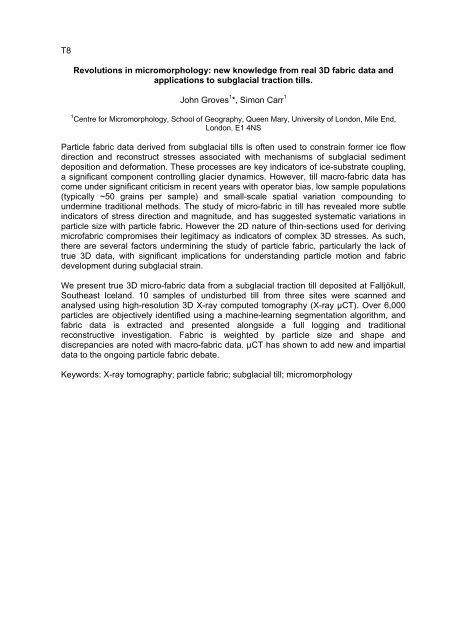The full programme book (PDF) - Royal Geographical Society
The full programme book (PDF) - Royal Geographical Society
The full programme book (PDF) - Royal Geographical Society
You also want an ePaper? Increase the reach of your titles
YUMPU automatically turns print PDFs into web optimized ePapers that Google loves.
T8<br />
Revolutions in micromorphology: new knowledge from real 3D fabric data and<br />
applications to subglacial traction tills.<br />
John Groves 1 *, Simon Carr 1<br />
1 Centre for Micromorphology, School of Geography, Queen Mary, University of London, Mile End,<br />
London, E1 4NS<br />
Particle fabric data derived from subglacial tills is often used to constrain former ice flow<br />
direction and reconstruct stresses associated with mechanisms of subglacial sediment<br />
deposition and deformation. <strong>The</strong>se processes are key indicators of ice-substrate coupling,<br />
a significant component controlling glacier dynamics. However, till macro-fabric data has<br />
come under significant criticism in recent years with operator bias, low sample populations<br />
(typically ~50 grains per sample) and small-scale spatial variation compounding to<br />
undermine traditional methods. <strong>The</strong> study of micro-fabric in till has revealed more subtle<br />
indicators of stress direction and magnitude, and has suggested systematic variations in<br />
particle size with particle fabric. However the 2D nature of thin-sections used for deriving<br />
microfabric compromises their legitimacy as indicators of complex 3D stresses. As such,<br />
there are several factors undermining the study of particle fabric, particularly the lack of<br />
true 3D data, with significant implications for understanding particle motion and fabric<br />
development during subglacial strain.<br />
We present true 3D micro-fabric data from a subglacial traction till deposited at Falljökull,<br />
Southeast Iceland. 10 samples of undisturbed till from three sites were scanned and<br />
analysed using high-resolution 3D X-ray computed tomography (X-ray µCT). Over 6,000<br />
particles are objectively identified using a machine-learning segmentation algorithm, and<br />
fabric data is extracted and presented alongside a <strong>full</strong> logging and traditional<br />
reconstructive investigation. Fabric is weighted by particle size and shape and<br />
discrepancies are noted with macro-fabric data. µCT has shown to add new and impartial<br />
data to the ongoing particle fabric debate.<br />
Keywords: X-ray tomography; particle fabric; subglacial till; micromorphology
















